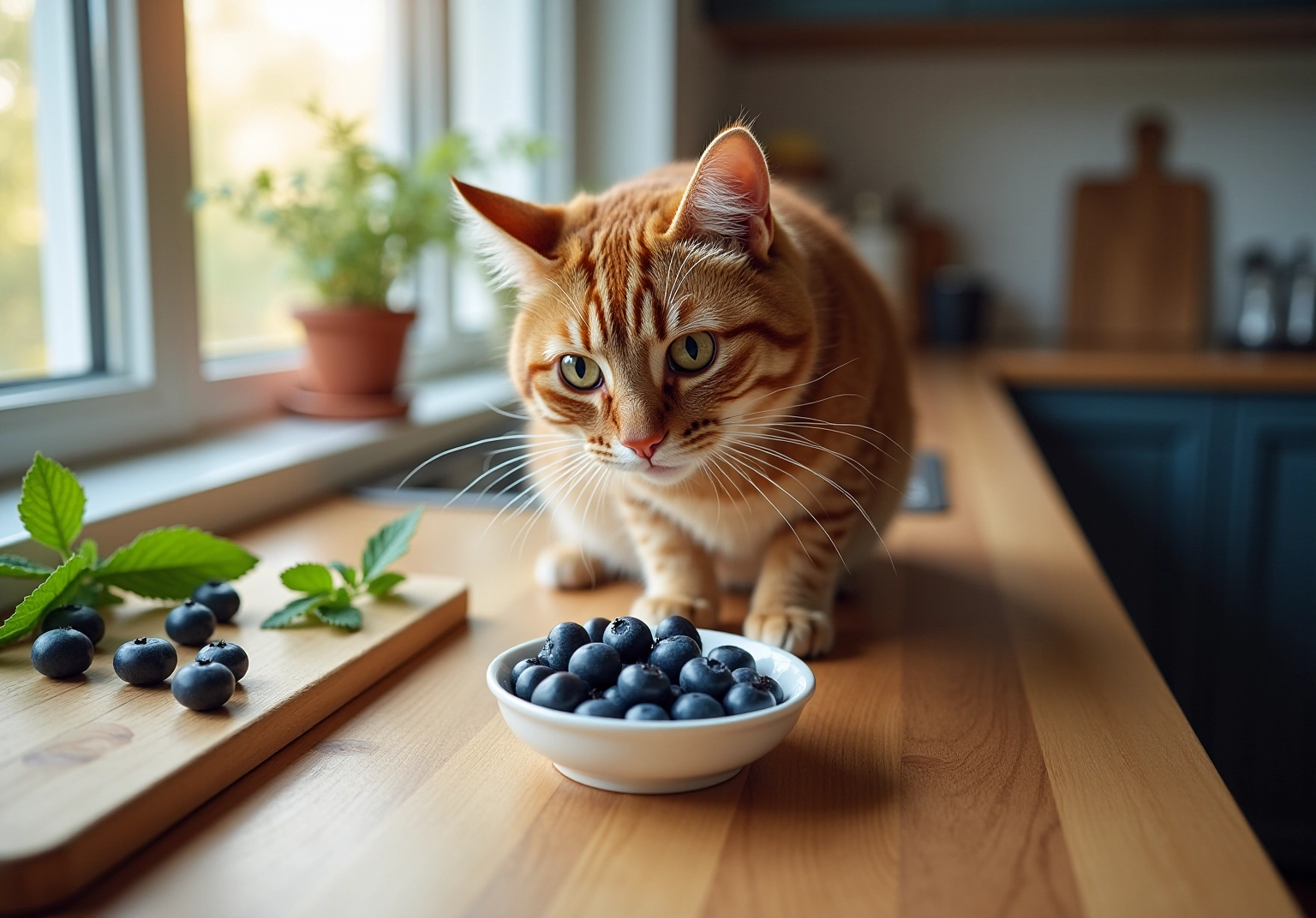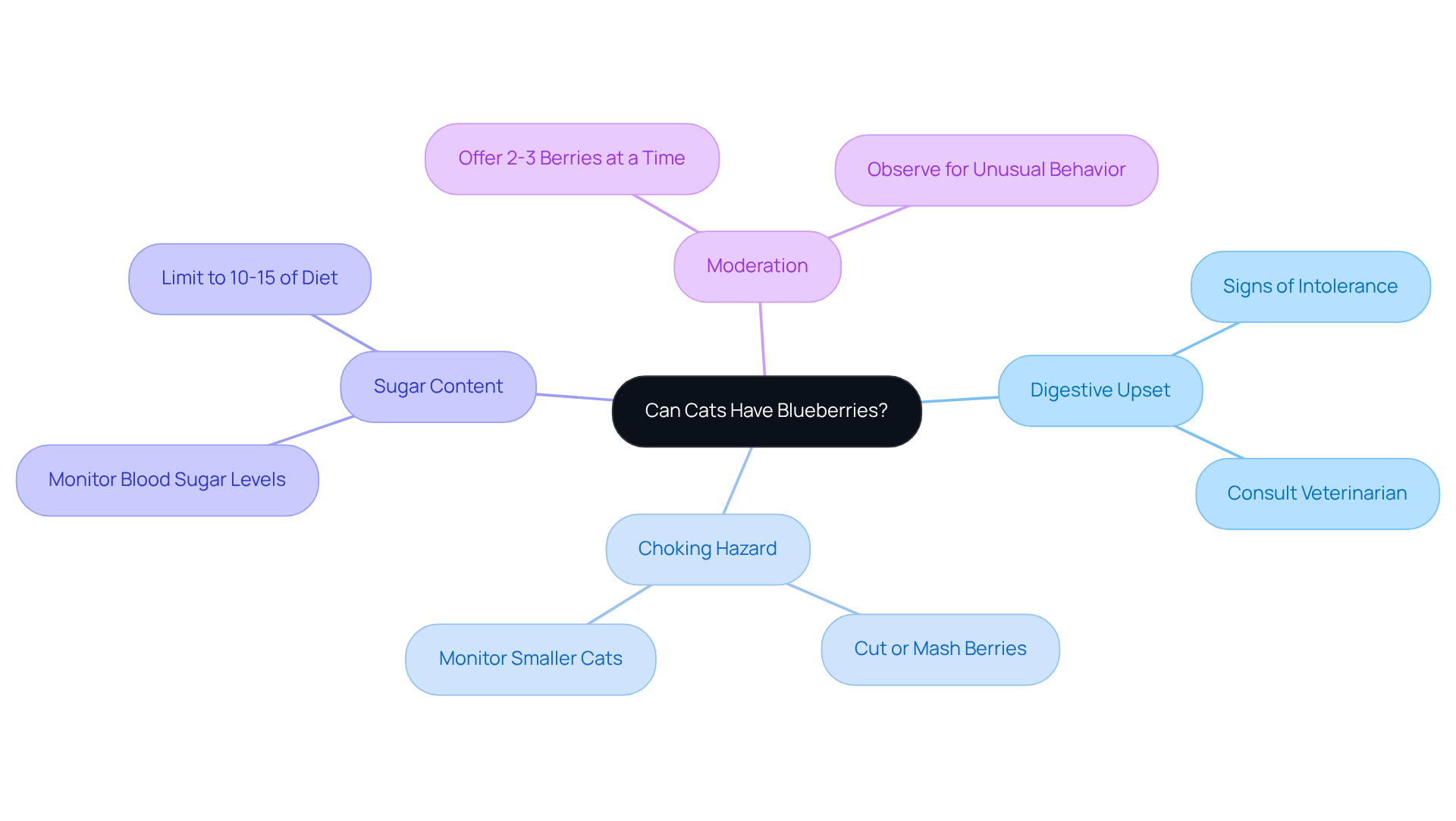
Can Cats Have Blueberries? Safe Steps for Introduction
Overview
As a loving cat owner, you may wonder about the best treats to offer your feline friend. It’s heartening to know that cats can safely enjoy blueberries as an occasional treat. These little berries are packed with antioxidants and fiber, which can contribute positively to their health. However, it’s essential to remember that they should only constitute a small portion of your cat’s diet.
While blueberries can enhance your cat’s nutrition, introducing them requires care. Monitor your pet for any adverse reactions and ensure that treats, including blueberries, do not exceed 10% of their overall intake. By approaching this new addition thoughtfully, you can nurture your cat’s well-being while keeping their diet balanced and healthy.
Introduction
As pet owners, our curiosity often drives us to explore new dietary options for our beloved feline companions. This leads us to ponder an important question: can cats enjoy blueberries? These small, vibrant fruits not only delight the palate but also provide a wealth of nutritional benefits, such as antioxidants and dietary fiber. Yet, we face the challenge of safely incorporating this treat into a cat’s primarily meat-based diet. It’s essential to consider what precautions we should take to ensure that this fruity indulgence enhances, rather than jeopardizes, our cats’ health. By approaching this topic with care and understanding, we can make informed choices that prioritize our pets’ well-being.
Understand the Nutritional Benefits of Blueberries for Cats
Many pet owners wonder, can cats have blueberries? These berries can be a delightful snack for your feline friend, offering significant nutritional benefits. These little fruits are packed with antioxidants, especially vitamin C and flavonoids, which help reduce oxidative stress and support your cat’s immune system. Additionally, the dietary fiber found in blueberries can aid in digestive health, something we all want for our beloved pets.
However, it’s essential to remember that cats are obligate carnivores, meaning their diet should primarily consist of meat. Therefore, while blueberries can be a fun and healthy treat, they should only make up a small portion—no more than 10%—of your cat’s overall diet. To ensure the best health of your furry companion, it’s wise to limit servings to just two or three berries at a time, particularly when you ask, can cats have blueberries? Always ensure these fruits are thoroughly washed before serving, and consider consulting with your veterinarian before introducing any new foods. This step is crucial to ensure that any additions to their diet align with your cat’s specific health needs.
It’s also important to be aware that some cats may have food sensitivities or allergies to certain fruits. Keeping a watchful eye on their reaction after their first taste is a good practice to ensure their well-being. By approaching their diet with care and consideration, you can help your cat enjoy the occasional blueberry treat while maintaining their health and happiness.

Follow Steps to Safely Introduce Blueberries to Your Cat
While introducing blueberries to your beloved cat can be a delightful experience, it’s essential to consider if cats can have blueberries safely. Begin by consulting your veterinarian, especially if your furry friend has any existing health issues or dietary sensitivities. As Louise, a Senior Veterinary Nurse, wisely advises, “If you’re ever unsure about introducing new foods into your cat’s diet or have concerns about potential allergies, it’s always a good idea to consult a veterinarian.” This step ensures that you are making the best choice for your pet’s well-being.
Next, choose fresh, organic blueberries to minimize exposure to harmful pesticides and chemicals. It’s a simple act of care to wash them thoroughly under running water, removing any dirt or residues that could affect your cat.
Start small by offering just one blueberry to determine if cats can have blueberries. This gentle introduction allows you to observe your cat’s reaction for any signs of discomfort or allergies, such as vomiting or diarrhea. Your attentiveness can make all the difference in ensuring their safety.
If your cat seems hesitant to eat the whole fruit, consider cutting it in half or mashing it to facilitate easier consumption. This small adjustment can help reduce the risk of choking, showing your understanding of their needs.
After introducing the blueberries, monitor your cat closely to determine if cats can have blueberries without any negative reactions. If they enjoy the treat and show no adverse effects, you can gradually increase the quantity to two or three fruits a few times a week. Remember, you might wonder if cats can have blueberries, as they can be a wonderful way to help with hydration due to their high water content, adding a refreshing touch to their diet.
However, it’s important to limit the frequency of this treat. Blueberries should only be an occasional indulgence, not a regular part of their meals. Ensure that the majority of their nutrition comes from a balanced cat meal, as fruits should constitute no more than 10% of their overall intake. It’s recommended to keep their blueberry treats to 2-3 berries daily, allowing them to enjoy this delightful snack while maintaining a balanced diet and preventing digestive issues. Your care and attention to their dietary needs will foster a happy and healthy life for your feline companion.

Address Common Concerns and Troubleshoot Dietary Issues
When introducing blueberries or any new food to your beloved cat, you should consider the question of can cats have blueberries and approach the situation with care for their well-being.
-
Digestive Upset: With nearly 60% of cats classified as overweight or obese, it’s vital to observe how your feline friend reacts to new foods. If you notice any signs of vomiting or diarrhea after they indulge in these fruits, it’s best to consult your veterinarian regarding can cats have blueberries and discontinue offering them. These symptoms may indicate an intolerance or allergy, and being vigilant is crucial when introducing anything new to their diet.
-
Choking Hazard: Whole berries can pose a choking risk, particularly for our smaller companions. To ensure their safety, always cut the berries in half or mash them before offering them. This simple precaution can help prevent any choking incidents and keep your furry friend safe while they enjoy a treat.
-
Sugar Content: Blueberries contain natural sugars that could affect your cat’s blood sugar levels. It’s important to monitor their overall sugar intake, especially if they are diabetic or struggling with weight, to understand if can cats have blueberries. Obesity remains one of the most common nutrition-related issues in cats. When considering if can cats have blueberries, it’s important to remember that treats like blueberries should constitute no more than 10 to 15 percent of your cat’s daily caloric intake to ensure they remain healthy and happy.
-
Moderation is Key: Remember that treats, including blueberries, should not exceed 10 to 15 percent of your cat’s daily caloric consumption. Overindulgence can lead to digestive issues and contribute to obesity. A good rule of thumb when considering if can cats have blueberries is to offer no more than two to three berries at a time, a small portion that aligns with their dietary needs and keeps them feeling their best.
If you notice any unusual behavior or health concerns after introducing blueberries, it is important to consult your veterinarian for tailored advice on whether can cats have blueberries. Your cat’s health and happiness are of utmost importance, and seeking guidance can provide peace of mind as you navigate their dietary choices.

Conclusion
Introducing blueberries to your beloved cat’s diet can be a truly rewarding journey, but it requires care and consideration. These small, vibrant fruits are packed with nutritional benefits, including antioxidants and dietary fiber, which can positively contribute to your cat’s health. However, it’s essential to remember that cats are obligate carnivores, and fruits should only serve as an occasional treat, making up no more than 10% of their overall diet.
Throughout this discussion, we’ve shared key insights on how to safely introduce blueberries to your feline companion:
- Starting with a consultation with your veterinarian is crucial.
- Selecting fresh, organic berries is important.
- Closely monitoring your cat’s reactions is essential.
- Being aware of potential digestive issues, choking hazards, and sugar content ensures a safe snacking experience.
Remember, moderation is key; overindulgence can lead to health problems, and we want to keep our furry friends happy and healthy.
Ultimately, the decision to include blueberries in your cat’s diet should be approached with thoughtfulness and care. By prioritizing your cat’s health and well-being, you can offer these delightful treats while ensuring they remain a cherished member of your family. Take the time to observe and respond to your cat’s unique needs, and enjoy the beautiful journey of discovering new flavors together. Your love and attention make all the difference in their happiness.
